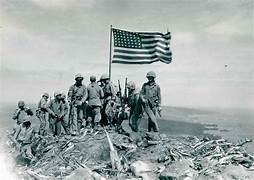Privacy Policy | Terms of Use | Cookie Policy | Disclaimer
Empowering the American middle class — one story at a time.
WWII & Postwar Era
World War II (1939–1945) was a turning point in American history. After the surprise attack on Pearl Harbor on December 7, 1941, the United States formally entered the global conflict. Millions of Americans enlisted or were drafted into the armed forces. The country united with a sense of shared purpose to defeat the Axis powers. While battles raged across Europe, North Africa, and the Pacific, Americans at home supported the war effort through sacrifice, production, and determination. Citizens bought war bonds, participated in rationing programs, and worked in industries that were now focused on manufacturing tanks, ships, and planes.
The war accelerated economic recovery from the Great Depression. Unemployment dropped sharply as factories expanded and workers were needed in nearly every industry. For the first time, women joined the workforce in massive numbers, with the iconic figure of "Rosie the Riveter" symbolizing the critical role of female labor. African Americans, Native Americans, and other minority groups also served in the military and contributed to war production, though segregation and discrimination remained widespread. These wartime experiences planted seeds for the social and civil rights changes that would follow.
Overseas, American forces played a major role in liberating Europe from Nazi control and securing victory in the Pacific after the use of atomic bombs on Hiroshima and Nagasaki in 1945. The war ended with the United States emerging as a dominant military and economic superpower, ushering in a new era of international responsibility and competition with the Soviet Union—what would become known as the Cold War.
The postwar years were marked by optimism, rebuilding, and transformation. The G.I. Bill provided millions of veterans with access to education, home loans, and small business funding. This led to the growth of suburbs, a housing boom, and the expansion of the middle class. The baby boom brought a surge in population, while television, automobiles, and appliances became central to American life. Schools and highways were built across the nation. However, prosperity was not equally shared.
The Cold War tensions soon grew. The Soviet Union’s control over Eastern Europe and the development of nuclear weapons created fear and uncertainty. Americans built fallout shelters, and schoolchildren practiced "duck and cover" drills. The Truman Doctrine and Marshall Plan aimed to contain communism and rebuild war-torn Europe, while the formation of NATO formalized alliances. Domestically, anti-communist sentiment fueled the rise of McCarthyism, where accusations and suspicion threatened civil liberties.
Despite this backdrop, progress continued. African American veterans returned from the war determined to fight for equal rights. This period saw early civil rights activism and landmark legal battles that challenged segregation in schools and public facilities. President Truman desegregated the armed forces in 1948, signaling a shift in government policy. The groundwork was being laid for the civil rights movement that would define the next era.
The postwar years also saw the rise of American culture as a global influence. Music, film, and literature reflected both the hope and anxiety of the times. Rock ’n’ roll was born, jazz spread internationally, and movies portrayed both patriotic pride and Cold War paranoia. Science advanced rapidly, driven by wartime research and the beginnings of the space race.
In many ways, the WWII and Postwar Era defined 20th-century America. It was a time of unity, sacrifice, resilience, and transformation. The choices made and the foundations laid during this time would shape foreign policy, civil rights, education, the economy, and the very identity of the American people for generations to come.

